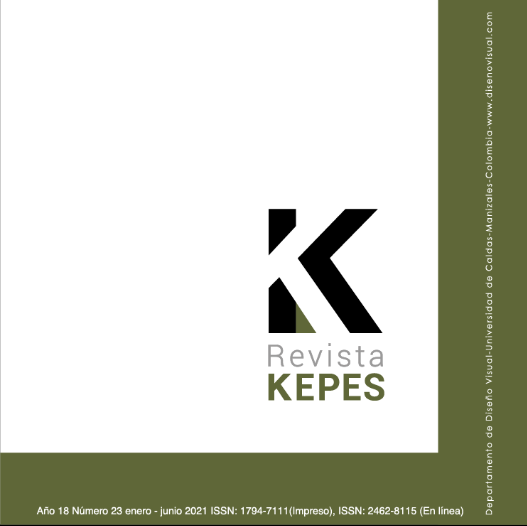Authors
Abstract
Traditional gastronomy, in addition to constitute a significant part of the tangible and intangible heritage of a society, constitutes a scenario with significant potential in the development of creative nd cultural industries committed to the protection and promotion of cultural diversity. Based on this conceptual framework, this article aims to project and make visible the market place of Riosucio Caldas, Colombia, as a scenario of culinary practices
capable of articulating the traditions and knowledge of traditional cuisines with economic growth. The methodological approach has a qualitative character that (through dialogue processes with the community) presents a reality full of historical, social, symbolic and aesthetic values that, when analyzed, resulted in the characterization of this Plaza as a space of heritage value with an important potential in the generation of creative economies, due to the great variety of manifestations resulting from the plurality of cultures that are intertwined there by social practices and factors such as collective work, cooperation and a culinary system full of syncretism that imprint this Plaza a legitimate identity built and enriched over centuries. In conclusion, the need for strategies that promote architectural recovery in this Plaza is highlighted as well as its social, cultural and economic sustainability in a binding way, the socialization of its knowledge, the promotion of its patrimonial value, and the transmission of its legacy to future
generations in a framework that encourages the cooperation of public and private, multisectoral and multidisciplinary actors.
Keywords:
References
Bello, C. A. (2003). Impacto Económico de las Industrias Culturales en Colombia. Bogotá: Unidad Editorial.
Benavente, J., & Grazzi, M. (2017). Public Policies for Creativity and Innovation: Promoting the Orange Economy in Latin America and the Caribbean.
Cámara de Comercio de Manizales. (1999). Monografía de Riosucio. Riousucio: Cámara de Comercio de Manizales.
Cano, G. A., Garzón, A., & Poussin, G. (2000). en.unesco.org. Fonte: https://en.unesco.org/creativity/sites/creativity/files/culture_trade_and_globalisation.pdf
Caraballo, C. (2011). Patrimonio Cultural. un enfoque diverso y comprometido. México: UNESCO.
Ernst & Young Global Limited. (2015). Tiempos de cultura: El primer mapa mundial de las industrias culturales y creativas.
González, C., & Sánchez, N. (2018). Cuadernos de Desarrollo Económico. Información Económica de las Industrias Creativas y Culturales en Bogotá. Bogotá D. C.: Secretaría de Desarrollo Económico de Bogotá.
Grandma’s Desing. (09 de 05 de 2015). http://www.grandmasdesign.com/.Fonte: Grandma’s Desing: http://www.grandmasdesign.com/
Hernández, O. (2006). El paladar de los caldenses. Manizales: Edigráficas.
Howkins, J. (2002). The creative economy: How people make money from ideas. UK Penguin.
ICOMOS 14th General Assembly and Scientific Symposium. (2003). INTANGIBLE CULTURAL HERITAGE INVOLVED IN TANGIBLE CULTURAL HERITAGE Nobuo ITO*, Japon / Japan. Zimbabwe: ICOMOS.
Instituto Nacional de Patrimonio Cultural de Ecuador. (2013). Guía metodológica para la salvaguardia del Patrimonio Cultural Inmaterial. Quito: INPCE.
Kelley, T., & Kelley, D. (2012). Reclaim your creative confidence. Harvard business review, 12(90), 115-118.
Largo, C. (2017). Receta de cocina tradicional en persona. (A. N. Ocampo, Entrevistador) Riosucio.
Lauer, M., & Lauer, V. (2006). La revolución Gastronómica Peruana. Lima: Universidad de San Martín de Porres.
Miele, M., & Murdoch, J. (1999). Back to Nature: Changing worlds of production in the food sector. European Society for Rural Sociology Ruralis, 39, 465-483.
Ministerio de Cultura de Colombia. (2012). Política para el conocimiento, la salvaguardia y el fomento de la alimentación y las cocinas tradicionalesde Colombia. Bogotá: Ministerio de Cultura.
Montoya. A. M. M. & Piedra, G. F. (2017). Mediciones Culturales. Resultados del proyecto: Elaboración e implementación de la Cuenta Satélite de Cultura, CSC, en los países del área andina. Observatorio Iberoamericano de Cultura website
R., S. (2012). Juntos. Riuales, Placeres y Política de Cooperación. Barcelona: Anagrama.
Sanders E., B. N., & Stappers , P. J. (2008). Co-creation and the new landscapes of design. Co-design, 4(1),, 4(1), 5-18.
Sanoff, H. (2000). Community participation methods in design and planning. John Wiley & Sons.
Sennett, R. (2012). Juntos. Rituales, placeres y política de cooperación. Barcelona: Anagrama.
Throsby, D. (2001). Economics and Culture. Cambridge: Cambridge University Press.
Torricelli, O. (27 de Octubre de 2014). Carlo Petrini: en América Latina, ha surgido una revolución gastronómica. Fonte: Radio Francia InternacionalEspañol: http://www.espanol.rfi.fr/americas/20141027-en-america-latinaha-surgido-una-revolucion-gastronomica
UNCTAD. (2008). unesco.org. Fonte: https://unctad.org/system/files/officialdocument/ditc20082cer_en.pdf
UNCTAD. (2013). unesco.org. Fonte: http://www.unesco.org/culture/pdf/creative-economy-report-2013.pdf
UNESCO. (1998). www.lacult.unesco.org. Fonte: http://www.lacult.unesco. org/docc/1998_Action_Plan_Cultural_Policies_for_Dev_UNESCO.pdf
UNESCO. (2003). Convención para la Salvaguardia del Patrimonio Cultural Inmaterial . Paris: Unesco.
UNESCO. (2007). Fonte: unesdoc.unesco.org: http://unesdoc.unesco.org/images/0014/001497/149708e.pdf
Zapata Bonilla, J. E. (1997). Visión del Occidente de Caldas. Supía: Gráficas Lancheros.

 PDF (Español)
PDF (Español)
 FLIP
FLIP
 Perfil Google Scholar
Perfil Google Scholar


















